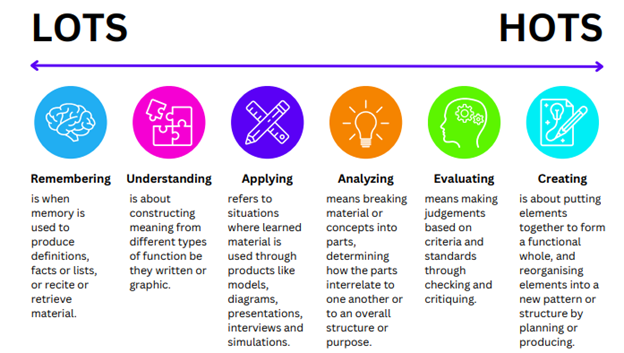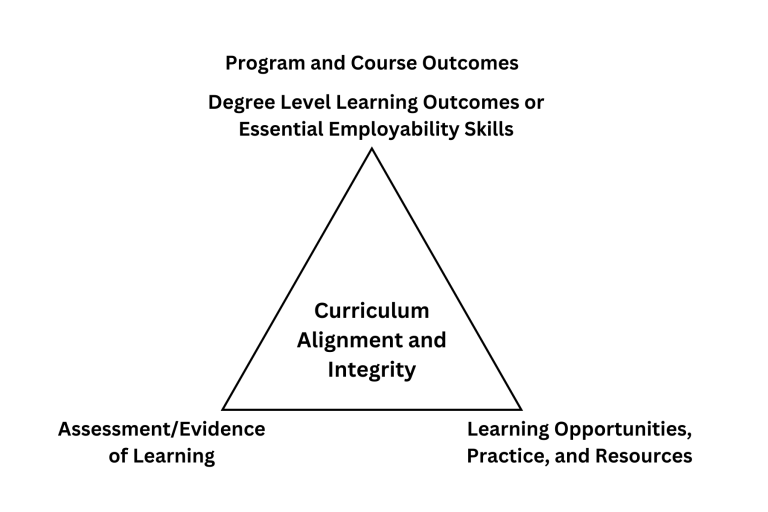Make your Lessons “Bloom!”: Leveraging Bloom’s Taxonomy for Lesson Planning Alignment
Are you ready to plan your lessons with clear objectives and see exactly what students learn by the end? Do you have your BOPPPS template ready to go and wondering how to take your course learning outcomes and put them into ‘action’?
Conestoga College follows an outcomes-based approach to teaching and learning. This teaching tip will explain how to take your course learning outcomes, match them to your lesson plan, and how using Bloom’s Taxonomy can be used to create activities that align with your outcomes and assessments.
What is Bloom’s Taxonomy?
Benjamin Bloom created Bloom’s Taxonomy in 1956 to categorize educational goals into specific stages (Arden, 2021). This educational framework shows the stages of lower order thinking (LOTS) to higher order thinking (HOTS). It progresses from the bottom or foundational area of ‘remember’ and uses verbs to build on the knowledge and skills that students acquire as they progress through their learning. Your course learning outcomes have been designed to support students from the foundational stages, progressing to levels of higher order thinking. See below for further description of each of the stages (Los Angeles Pacific University, n.d.).
Curriculum, Course & Lesson Alignment
Conestoga’s programs and courses are backwards designed. This means that outcomes are identified first, then assessments and teaching activities are created to ensure that students demonstrate the outcomes and have structured learning opportunities to practice and achieve the outcomes (Wiggins & McTighe, 2005).
Why should I use learning outcomes in my lesson planning?
Learning outcomes are direct statements describing the knowledge, skills, and attitudes students are expected to demonstrate by the end of a course or program. Learning outcomes are observable, measurable, and significant (TASC, 2023).
Each new course outline must be developed in collaboration with the curriculum department. For more information please contact: Curriculum Planning & Operations
A few things to keep in mind:
- The course learning outcomes are the key knowledge, skills and attitudes expected by the end of the course.
- The evaluations must align to the course learning outcomes
- The units include what needs to be taught in order to achieve the course learning outcomes
Your Course Outcomes can be found below the Course Description and Resources in your course outline.
How can I use learning outcomes in my lesson planning to ensure they align with my activities?
It is important to be explicit about which course learning outcomes you are working towards in your lesson planning. If using the BOPPPS model of lesson planning, after your Bridge, you can state the learning outcomes for the lesson and explain them to students. This creates a clear link between what they are learning and the activities they will participate in to achieve the outcomes.
Using Bloom’s for Lesson Planning
The Lecturer Planning Kit is a chart of the lower to higher order thinking verbs that you can reference when planning your lessons: Remembering, Understanding, Applying, Analyzing, Evaluating, and Creating (eCampus IHE Delft, n.d.). While it is important to acknowledge that there are three domains, cognitive, psychomotor, and affective (University of Waterloo, n.d.), the model focuses on the cognitive domain.
Note the key verbs in the chart under each of the verbs and the actions of what students could do to practice or show what they have learned. When looking at your course and unit outcomes, compare the verbs to those in the chart. This will assist you in choosing activities to meet these outcomes. Are your students at the beginning stages of their learning and are therefore in the area of lower order thinking (e.g. remembering, understanding)? Or, are they required to demonstrate higher order thinking using some of the verbs in the applying, analyzing, evaluating and creating? For example, if the outcome is in the area of lower order thinking “Remembering”, and is for students to identify the 3 parts of the atom, the question might be, “What are the 3 parts of the atom?” However, if the outcome is based on higher order thinking in “Synthesize”, you might ask, “What changes would you make to the design of your business model to increase success?”
There is also a questioning section at the bottom you may want to consider using in guiding and creating your active learning activities. For more information in creating effective questioning please see our hub post on Asking Effective Questions.
Ideally, we scaffold the learning experience for students, so they are able to meet the learning outcomes at the “Application” level. Post-secondary education in provincial colleges is expected to provide students with the ability and opportunities to apply their learning. The unit outcomes ‘scaffold’ the learning so by the end of the course they can successfully achieve the course learning outcomes and apply this knowledge in their intended industry.
For Further Support in Course Planning
Reach out to Curriculum Planning & Operations
Reach out to Teaching & Learning for Lesson Planning and Course Delivery
References
Arden, M. (2021). How to use Bloom’s Taxonomy to Support Learning Objectives: How to Use Bloom’s Taxonomy to Support Learning Objectives: https://www.prodigygame.com/main-en/blog/blooms-taxonomy/
eCampus IHE Delft.(n.d.) Updated Bloom’s Taxonomy Lecturer Planning Kit: https://ecampus.un-ihe.org/blocks/handbook/mindmap/UpdatedBloomsTaxonomyLecturerPlanningKit-cke.pdf
Los Angeles Pacific University. (n.d.). Bloom’s Digital Taxonomy Verbs: https://learn.lapu.edu/d2l/lor/viewer/view_private.d2l?ou=6606&loIdentId=242
Stoutenburg, S. (2023). Considerations for Course Planning: https://tlconestoga.ca/considerations-for-course-planning/
Teaching and Services at Conestoga (TASC). (2023). Outcomes, Alignment & Curriculum, TASC: https://ecampusontario.pressbooks.pub/tasc/chapter/module1-2/
University of Waterloo. (n.d.). Bloom’s Taxonomy. Centre for Teaching Excellence, University of Waterloo.https://uwaterloo.ca/centre-for-teaching-excellence/catalogs/tip-sheets/blooms-taxonomy






